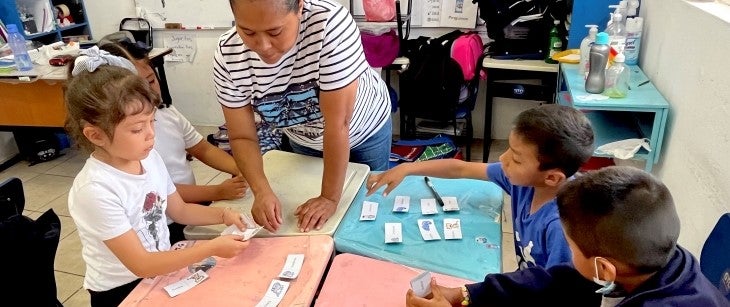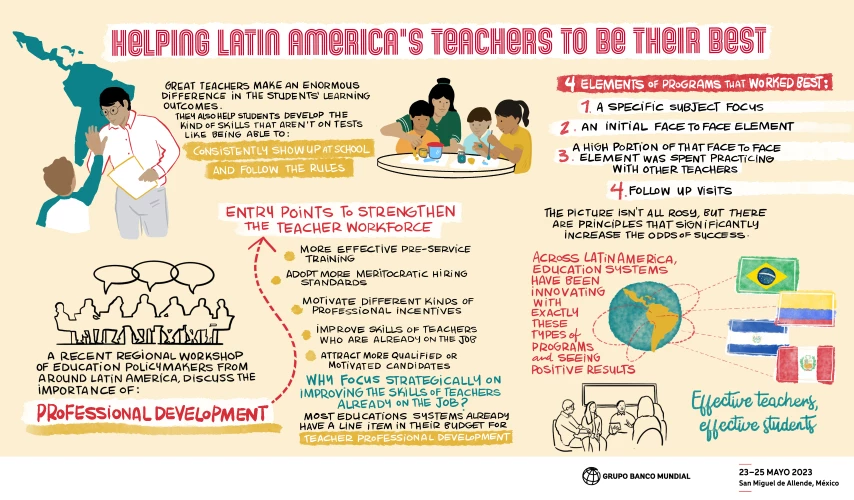 Docente y alumnos de escuela primaria en Guanajuato, México
Docente y alumnos de escuela primaria en Guanajuato, México
There is no substitute for an effective teacher. Great teachers make an enormous difference in their students’ learning outcome s: in Ecuador, teachers who had higher quality interactions with their kindergartners improved their language and math skills. Just as importantly, great teachers help students develop the kinds of skills that don’t get measured on most tests but pay off in life, like being able to consistently show up at school and follow rules.
There are lots of entry points to strengthen the teacher workforce. Education systems can try to attract more qualified or more motivated candidates. They can make pre-service training more effective. They can adopt more meritocratic hiring standards. They can motivate teachers with different kinds of professional incentives. And they can improve the skills of teachers who are already on the job—what we call teacher professional development.
Among all these options, why focus on teacher professional development?
First, professional development (PD) for teachers of basic education is often under the direct supervision of a part of the Ministry of Education that oversees basic education. Pre-service training often falls under the supervision of universities, with a fair amount of autonomy. Teacher hiring changes may require legislative approval. But what about a program to support teachers who are currently working? That falls right within the oversight of the Ministry.
Second, teacher professional development interventions are often less contentious than other reforms. Changes to the nature of teacher hiring or to the structure of teacher compensation are often met with strong opposition. But many teachers are happy for the opportunity to receive more support to do their jobs. Don’t get me wrong. Not every teacher professional development program is popular. But the odds are better!
A recent review of teacher professional development programs across middle- and low-income countries found a few characteristics that distinguish those programs that result in clearly improved student learning. Some programs that worked best to help teachers help students had more of these four elements :
- A specific subject focus: They were focused on helping teachers to teach basic literacy or specific mathematics concepts, not on general principles of teaching.
- An initial face-to-face element: They provided teachers with some concentrated content in a context where they could focus and learn it.
- A high proportion of that face-to-face element was spent practicing with other teachers: Teachers don’t learn from long lectures any better than children do. Giving them the chance to practice effectively with other teachers before they get back to their classrooms gives them a leg up.
- Follow-up visits: Even when teachers learn new content at a face-to-face training, translating it into classroom practice can be a challenge. An element of coaching can help teachers make that crucial transition.

Innovative education systems across Latin America
Some education systems have been innovating with exactly these types of programs and seeing positive results. Here are a few examples. (While I highlight one of the above principles in each example, these programs incorporate multiple strong principles.) For a program with a specific thematic focus, consider El Salvador’s effort to provide new mathematics textbooks and workbooks for students, together with initial training for teachers, structured peer review meetings among teachers to improve use of the new books, and then evaluations that teachers could use to gauge student learning along the way. The program boosted math scores at both the primary and secondary levels.
For a program that includes face-to-face training, consider Ceará, Brazil’s Program to Achieve Literacy at the Right Age, which provided detailed learning guides for teachers together with face-to-face training 3-5 times per year and follow-up visits. The program boosted student performance in both reading and mathematics.
For a program that has provided regular coaching visits, consider the Pedagogical Accompaniment program (Acompañamiento Pedagógico) in Peru. Monthly visits to teachers in rural schools to coach them toward better teacher practice led to better teaching and more learning over the course of three years. In Colombia, the initial design of Everyone Learning (Todos a Aprender), a program that teaches how to read, included materials and training but limited follow-up with teachers: it had no impact on student test scores. But an updated version added more structured, intensive follow-up visits and boosted both reading and math scores. The follow-up visits were the key to making all the rest work effectively.
The picture isn’t all rosy: teacher professional development programs are not a sure bet. Most at-scale programs don’t apply these principles, and there are many programs that have little to no impact on teacher practice—much less student learning—either because they’re too theoretical, because they’re implemented poorly, or in some cases, if we’re honest, for reasons we’re not entirely certain of.
But, as we see above, there are successes in the region and around the world, and there are principles that significantly increase the odds of success. Most education systems already have a line item in their budget for teacher professional development. We owe it both to the teachers we’ve already hired and to the students they serve to equip those teachers with the best possible skills—drawing on already established principles and continuing to innovate and evaluate to apply those principles most effectively in new settings.
At a recent regional workshop of education policymakers from around Latin America, we discussed why teacher professional development is a crucial tool in helping them to be their best, and what needs to happen for it to change teacher practice and student learning.
Watch the following video to learn more (in Spanish):
To receive one article a week,
Related Articles:


Join the Conversation